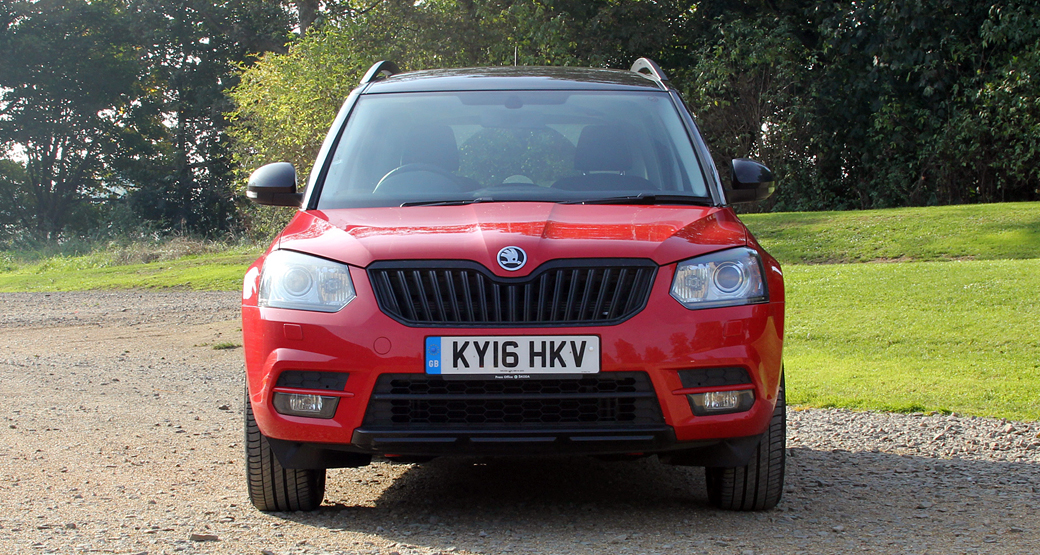OK so the Skoda Yeti is a great little compact SUV with entry-level models retailing for a relativity affordable £17k, it has a great range of engines, model specs (around 32) and equipment levels. And that’s the end of the review right? Wrong, the Yeti first launched in 2009 and over the preceding years has received a number of upgrades to the exterior styling and equipment levels have grown relative to new technology trends. The Yeti also gets an extra naming suffix, meet the Skoda Yeti Outdoor.
The Yeti’s overall exterior styling is pretty much unchanged, however subtle styling updates in 2014 included a re-designed headlight cluster and new corporate grille and front and rear bumper, introduction of LED daytime running lights all of which did a good job of keeping the Yeti looking youthful. With the times.
Without going into dimensions, the Yeti looks compact from the outside but get into the drivers seat and it feels larger then the exterior suggests, there is a good amount of space for the average-sized person.
However for rear-seated passengers, it’s a slightly different story. While there is a good amount of headroom, leg room could be tight for those who maybe above average height. But it’s OK right? it is what it is after all what do you expect from a compact SUV? Compact space is what you get.
Overall the interior is also pretty much unchanged however the build remains solid a ever and the range of materials used throughout are good.
The Yeti’s engine line up has changed, the 1.6-litre diesel engine is no more with only the 2.0-Litre, 4-cylinder unit which is available in two states of power, 108bhp and 150bhp.
There are two petrol engines available, entry level specs make do with the 4-cylinder, 1.2TSi unit and more expensive model trims make do with the 1.4-litre TSi.
You can spec either a 6-speed manual or 7-speed DSG auto transmission with 4×4, all are available across the entire range.
Equipment levels are good, entry-level models as standard come primed with a 5-inch infotainment touchscreen, air-con, alloy wheels, Bluetooth, the basics but essentials. Obviously, the higher up the trim levels you go the more equipment opens up.
For example, move up to the second tier SE trim level and that miserly infotainment system is now transformed into a 6.5-inch touchscreen and you get upgraded 17-inch alloys. At the end of the day It’s really up to you what options and trim you go for.
Press cars always come loaded with extras, if you expect DAB to be standard equipment these days it isn’t on the Yeti because it’s a £135 optional extra, the Sat Nav is a £755 optional extra, heated front seats cost an extra £255. With other minor optional extras, the Yeti Monte Carlo actually cost £22k all in.
The Yeti Monte Carlo Edition is a limited in numbers and to be honest it isn’t too far removed from the range-topping SE-L model. What you have is that bright red paint finish and a two-toned gloss black roof.
So you get the heated front seats, sports seats with Monte Carlo designed upholstery, upgraded 17-inch alloy wheels and a unique to spec Monte Carlo Instrument cluster.
Perhaps the main distinguishing feature is the amount of Monte Carlo decals, there are many just to remind why you decided to go for this particular model spec.
The Yeti has always had excellent driving manners, it’s quite agile through a series of bend, it’s rather quiet fun to drive and isn’t too bad on a long haul drive to No-wheres-ville.
Combined with the seven speed DSG the Yeti had super-snappy gear changes and the 1.2-TSI engine suited the chassis well. However as with all small capacity turbo-charged engines you loose that lazy accessibility to the power delivery, these engines always feel as though they are on a bit of a high.
The engine which outputs 108bhp/175Nm sounds asthmatic but it’s decidedly swift and has little to no turbo lag thanks to combined effects of supercharging and turbocharging.
But don’t expect spectacular mpg, well maybe 42mpg isn’t too bad, and at least you don’t get the constant drone and vibration of a diesel engine to contend with.
As I said previously interior space is not going to be a priority with a compact SUV, it is what it is. However with the rear seats folded and that SUV high roofline you can shove a decent amount of stuff into the Yeti’s cargo bay.
So overall the Yeti is another consistently good offering from Skoda, it’s aged fairly well and still feels fresh as a daisy to look at and drive and better still you can probably get a really good finance deal if you shop around.
But as always rivals have stepped up the competition. The Yeti has to compete with the likes of the new Kia Sportage which offers a more refined experience all round than the current Yeti.
But don’t expect to see an all-new replacement for the Yeti until 2018, for Skoda the game is now surely on, the next generation is waiting.








